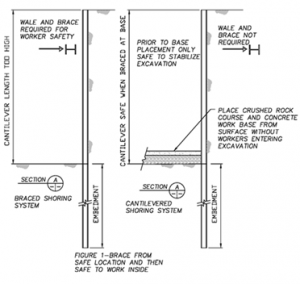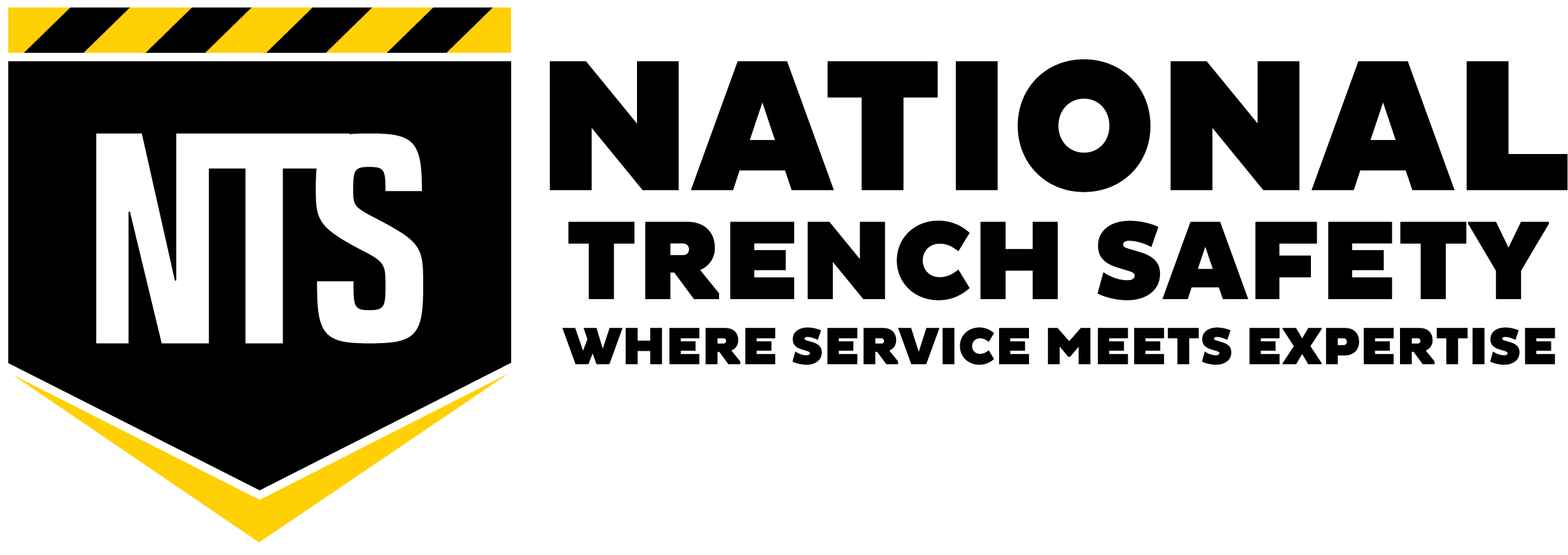Knowledge Article: Excavations
The Occupational Safety and Health Administration (OSHA) establishes basic standards for employee protection when working in and around excavations. These standards are very important for keeping employees safe, as well as establishing employer responsibilities. The OSHA standard addresses excavations in 1926.652(a)(1) specifically stating that employees must be protected from cave-ins while working in excavations. A reading of the standard also provides several practical takeaways for employers:
- The instructions contained in this specific standard only apply to when workers are inside the excavation. If no employees are in the excavation, it may be any depth and shored as necessary to protect the stability of the excavation and surrounding facilities.
- When an excavation is designed solely to protect the stability of the excavation and surrounding facilities there should be some visible means of notifying workers that the excavation is not properly shored for worker protection.
- All employers have a responsibility to evaluate the “protective system” for the safety of its workers. If one firm constructs the protective system, the competent person for each employee must still evaluate the system and decide if it provides adequate protection for the competent person’s employer.
- Adequate protective systems are determined by two factors: (1) the loading from the soil and (2) the structural capacity of the resisting protective system. These two factors are why soil classification is the first thing that should be done on any jobsite and then a protective system selected for worker protection to resist the soil loading.
- The employer is responsible for selecting the worker protection system. Employers may consult with shoring manufacturers, shoring suppliers and engineers but it is ultimately the responsibility of each and every employer, through its designated competent person, to select and follow through on the worker protection for the site.
Reading the OSHA standard and properly applying the principles helps to ensure that employers are operating safely and managing costs. Throughout my engineering career, I have seen a lot of excavations shored to worker protection standards when there was no need for workers to enter the excavation. In these cases, proper planning could have allowed a contractor to use a system designed to support the excavation and adjacent structure with potential savings in both time and cost. A few examples include:
- Hydraulic vertical shores spaced at 12′ to 16′ on center can stabilize an excavation for a 40′ length of pipe. The 12′ to 16′ on center spacing is not provided within tabulated data, however, it is perfectly acceptable so long as employees are aware that they cannot enter the excavation in those areas.
 Cantilevered (meaning a system that is not braced at the top) sheet pile shoring to an 18’ depth may not be safe to work in, however, it might become stable and safe after base rock and a slurry work base is in place. In this case, if an installation and work procedure working from the surface to place the base can be devised, the strutting from the top can be eliminated thereby providing huge savings in the shoring system cost. (Figure 1)
Cantilevered (meaning a system that is not braced at the top) sheet pile shoring to an 18’ depth may not be safe to work in, however, it might become stable and safe after base rock and a slurry work base is in place. In this case, if an installation and work procedure working from the surface to place the base can be devised, the strutting from the top can be eliminated thereby providing huge savings in the shoring system cost. (Figure 1)
These two examples highlight how a thorough understanding of the OSHA Subpart P standard can help a competent person properly design shoring and shielding systems. In the hydraulic shore example, the contractor can do this simply with proper planning to make sure employees are aware and that the ground will not collapse if shores are placed greater than 8′ on center as stipulated in the tabulated data. In the second example, and many others, these alternatives should be discussed with the contractors shoring design engineer. The key terminology for this is “shored for excavation stability and protection of existing surrounding facilities” or shored for “worker protection”.
About the Author:
Joe Turner, P.E. serves as National Trench Safety’s Director of Engineering, Research and Product Development. Mr. Turner is one of the most recognized figures in the trench safety industry, having provided trench safety plans for the last 20 years. Among his many accomplishments, is the book Excavation Systems, Design, Planning and Safety, which was published by McGraw-Hill in 2008 and is still used today as a reference for many students and professionals regarding proper engineering techniques.
DISCLAIMER: the information contained in this article is provided for general and illustrative purposes only and is not to be considered Site Specific and or designated engineering for any project or work zone, nor is it to be used or consider to be tabulated data, technical data, advice and or counsel to be used on any jobsite. Each project is different and is the responsibility of the employer’s designated Competent Person to make decisions upon what systems and methods may be used in compliance with the federal and local regulations, manufactures tabulated data, engineered drawings and other plans.





